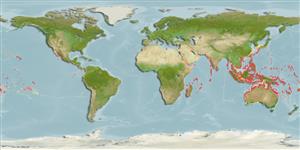Common names from other countries
Classification / Names / Names
Namen | Synonyme | Catalog of Fishes (gen., sp.) | ITIS | CoL | WoRMS
Environment: milieu / climate zone / depth range / distribution range
Ökologie
; tiefenbereich 2 - 30 m (Ref. 349). Tropical
Indo-Pacific.
Length at first maturity / Size / Gewicht / Alter
Maturity: Lm ? range ? - ? cm Max length : 36.0 cm ShH Männchen/unbestimmt; (Ref. 349); common length : 22.0 cm SHL Männchen/unbestimmt; (Ref. 349)
Frequently collected in the area for food and for the shell which is traditionally used as a decorative item in many parts, or as container for liquids by the natives of the South Seas (Ref. 349). Live in colonies. During periods of activity, lift their shell straight up to move forward, then drop it down. Often partially buried below the surface of sand when inactive or during feeding. Preys on the crown-of-thorns Acanthaster planci, which is recently responsible for the devastation of many coral reefs (Ref. 349).
Life cycle and mating behavior
Geschlechtsreife | Fortpflanzung | Ablaichen | Eier | Fecundity | Larven
Members of the order Neotaenioglossa are mostly gonochoric and broadcast spawners. Life cycle: Embryos develop into planktonic trocophore larvae and later into juvenile veligers before becoming fully grown adults.
Poutiers, J.M. 1998. (Ref. 349)
IUCN Rote Liste Status (Ref. 130435)
CITES Status (Ref. 108899)
Not Evaluated
Not Evaluated
Nutzung durch Menschen
Fischereien: kommerziell
| FishSource | Sea Around Us
Tools
Internet Quellen
Estimates based on models
Preferred temperature
(Ref.
115969): 24.6 - 29.3, mean 28.4 (based on 3285 cells).
Verwundbarkeit
Low to moderate vulnerability (26 of 100).
Preiskategorie
Unknown.
